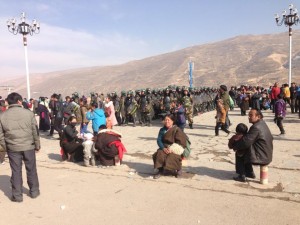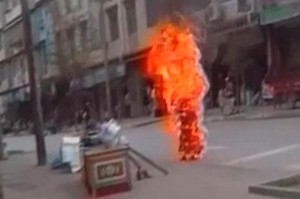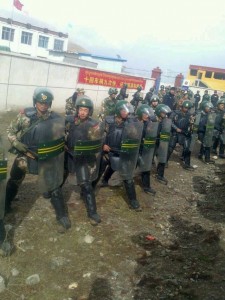
This week, China issued a white paper titled “Development and Progress of Tibet” which contained stunning claims of improved situation inside Tibet. Indeed the release of the white paper on the day of China’s second Universal Periodic Review (UPR) at the UN Human Rights Council was a strategic move. However, if China thought that a mere white paper filled with omissions, human rights doublespeak and calculated obfuscation would help blunt criticisms against its egregious human rights record in Tibet, it turned out to be just another exercise in self-delusion.
Like its white papers on Tibet issued in the past, the latest one begins by distorting not just the current reality of Tibet, but also Tibet’s history, denying its distinct identity as a nation and civilisation having its cultural influence beyond its Himalayan borders – in regions and countries as diverse as Sikkim, Ladakh, Arunachal Pradesh, Baltistan, Kalmykia, Mongolia and so on.
A notable feature of the latest white paper is the extent to which China redefines the concept of human rights reinforcing its prejudice against the universal nature of human rights. The white paper suggests that economic development is the sole indicator of China’s respect for human rights in Tibet. But what has human rights got to do with the possession of a motorcycle or a refrigerator? Some of the Tibetans who died of self-immolation protests used their motorcycles to reach the site of the protest where they died calling for human rights and freedom.
China considers the top-down approach to development, which has destroyed traditional livelihood, self-reliance and fragile ecology, a “great practice for respecting and guaranteeing human rights”. The white paper even goes further calling the exploitative, exclusionary development policy in Tibet as a “victory of human justice”. What was not mentioned is that under the banner of ‘development and progress’, China consistently justifies human rights abuses in the name of ‘stability maintenance’ policy.

One of the fundamental problems with all of China’s white papers on Tibet is the failure to acknowledge, let alone address current human rights abuses inside Tibet. Based on some warped logic, China thinks that rehashing the same old criticisms against ‘serfdom’ in ‘old Tibet’ would somehow magically right all the human rights wrongs it has committed for the past six decades in Tibet. While China accuses ‘old Tibet’ of perpetuating ‘feudal serfdom’, it has gone a step further, by turning Tibet into a human rights catastrophe with colonial overtones.
Before putting into perspective all the disinformation and doublespeak spewed by the latest white paper, it is important to invoke the wisdom of Mahatma Gandhi who had said:
What difference does it make to the dead, the orphans and the homeless, whether the mad destruction is wrought under the name of totalitarianism or the holy name of liberty and democracy?
According to the latest white paper, Tibetans have become “true masters of the country, society and their own fate” thanks to “democratic reforms and regional ethnic autonomy” law. The white paper cites ‘village self-governance system’ and the holding of periodic elections for Villagers’ Committees as evidences that meaningful rural democracy exists in Tibet. Nothing can be further from reality.
When China first introduced the so-called village self-governance system, the village elections were meant to be held outside of the party system and designed to give local elected officials the ability to manage their own affairs via the creation of village committees of between three to seven local residents. But in practice the chairman of the villager’s committee is almost always the village party secretary.
However, the basic law to exercise village democracy called the Organic Law of Villagers Committees of the People’s Republic of China (OLVC) has failed to implement meaningful grassroots democracy in Tibet. In fact, the English translation of the OLVC for Mainland China is worded differently from the OLVC for the Tibet Autonomous Region (TAR). The immediate differences are the emphasis on the ‘electoral committee’ that reports to higher-level people’s government, and the need for candidates to satisfy certain criteria including that “the candidate member of a villagers’ committee shall support the Chinese Communist Party (CCP), love socialist China and the unity of nationalities and oppose separation”.
TAR administration is subservient at each of the four levels of government to their counterparts in the party, who are at the highest levels of the CCP invariably Chinese. Although the administrative level may administer and disseminate policies and campaigns, the formulation of those policies and the laws, which affect the daily lives of local people, lie with the highest level of the party.
Given that the level of unrest has increased over the last three decades, leading to the Tibet Uprising in 2008 and 128 self-immolation protests during the last UPR period, the application of a specially tailored OLVC to TAR must lead one to question the nature and intention of the OLVC. It is hardly likely, given clear detestation of many CCP policies in TAR and other Tibetan areas, that the OLVC has been introduced to give representation. Unlike in the areas of mainland China, where representation may curb corruption in the lower cadres and build harmony, the infrastructure of democratic process may well increase, not relieve, tension if it is perceived to be another oppressive measure.

A recent report by the TCHRD is another illustration of party control at village level. After several hundred villagers gathered peacefully in Tawu (Ch: Daofu) County to celebrate the Tibetan spiritual leader, His Holiness the Dalai Lama’s birthday, they were beaten up and fired upon with live ammunition and tear gas. Since then, local officials in Tawu have introduced five major ‘stability maintenance measures’. These new rules relate to changing the local cadre system in order to root out any cadre whose “political stand” is not clear. Cadres in Tawu are to be rotated every three years, interrogated to assure their allegiance to the party and investigated as to their backgrounds. Other measures relate to dissemination of party propaganda via compulsory village propaganda meetings each week established by special work teams and new village surveillance measures. These include a new rule that requires a CCP cadre to live within the home of a Tibetan family for at least ten days out of every six months. These new conditions may well effect local elections for villagers’ committees.
Interviews conducted by TCHRD in recent months demonstrate that the OLVC has not been implemented in Tibet. It may be that the CCP fears implementation of the OLVC in its legal form, in particular articles 2 and 14, until it feels it has a grip on the rural population and has converted them, via ‘patriotic education’, from Tibetan Buddhism to ‘socialist thinking’.
There is no indication that those living in Tibetan villages can effectively exercise any of the rights provided for in the OLVC. Early research illustrates that instead of nominating their own candidates, they are presented with a list of pre-determined candidates to choose from. In one instance, villagers hopeful of representation and aware of international electoral norms were prohibited from nominating a candidate. Officials have filled out voter’s ballots for individuals and for groups. There have been no private ballot boxes. Electoral supervision is provided by the CCP and candidates must be presented to a higher level of the CCP before the election process. Neither has there been any indication of polling booths, discussion of policy by village committee members or campaigning. Seemingly candidates have no policies. Voters are given no indication that the village election, or the committee, is a forum, where they can elect a candidate to represent them and their concerns. Rather they perceive the village committee as an organ of the state that announces CCP policies and campaigns.
Without effective methods of electing officials who can represent the aspiration of the people, Tibetans have resorted to directly petitioning the central government to inform them of the problems at village level. Earlier this year four Tibetans were detained for petitioning in Beijing. These arrests removed another opportunity for Tibetans to participate in public debates and civil society.
In light of continued party interferences in local matters, the implementation of the Regional Ethnic Autonomy Law like the OLVC has remained a myth rather than reality. What difference would it make to ordinary Tibetans if official statistics show that 70.53 percent of TAR local officials are either Tibetans or “other ethnic minorities” when they only serve as servile conduits to policies made in Beijing.
In the section on ‘Environmental Protection and Ecological Improvement’, the white paper blames global warming for almost all the environmental ills in Tibet, conveniently side-stepping harmful environmental practices sanctioned by the local authorities in their race to increase GDP growth figures. Global warming does not occur in vacuum.
China’s environmental protection laws have failed to protect the environment. Tibetans are shot at and beaten up for peacefully petitioning local authorities to implement the environmental protection laws. The creation of ‘nature reserves’ on the Tibetan plateau ostensibly for “ecological improvement” has caused the relocation and eviction of tens of thousands of nomads and farmers off their ancestral lands. In August 2013, local Tibetans in San Jiang Yuan Three Rivers Headwaters Nature Reserve were shot at with teargas shells and severely beaten up for protesting mining activities that cause pollution of drinking water sources such as rivers and lakes causing death and destruction of Tibetan lives and their herds. Tibetan environmental activists are arrested and imprisoned on trumped up charges, and in some cases, Tibetan NGOs working to protect the environment have been forcibly closed when their activities threatened exposing illegal collusion between mining companies and local authorities.
The white paper insists that the current development policy in Tibet is the “right path” backing this fallacious claim with a host of statistics on the number of heavy infrastructure and industrial projects being implemented in Tibet. According to China’s 12th Five-Year Plan (2011-15), mining and infrastructure construction needed for resource exploitation and transportation form the bulk of government investment in Tibet. Last year, the official China Daily reported that “mining industry will need governmental financial support of 16 billion yuan and social investment of 32 billion yuan” during the 12th FYP. According to China analyst Ashok Tiku, the 12th FYP is focused on strengthening strategic infrastructure in Tibet, which includes the establishment of emergency relief and rescue bases, new railway projects, expressways and expansion of airports. The point is the real beneficiaries of these development projects are not ordinary Tibetans but the Chinese government and Chinese migrants.
It is well documented by international development scholars, including Andrew Fischer, development economist and Senior Lecturer in Population and Social Policy at the Institute of Social Studies in The Hague (Netherlands) that China’s economic development projects in Tibet has mainly benefitted the CCP members and the Chinese migrants moving into Tibet from Mainland China. Tibetan natives, on the other hand, are economically and culturally marginalised given that political decision-making power remains in the hands of the party, which is controlled overwhelmingly by Chinese.
It is important to understand the political context within which China implements its policies in Tibet. For instance, the white paper claims that the building of a ‘new socialist countryside’ in Tibet has “greatly benefited local farmers and herdsmen”. However, there is no mention of the involuntary and forced nature of building the “new socialist countryside” and the new mass surveillance and propaganda campaigns implemented since late 2011. If anything, the building of ‘new socialist countryside’ has made it easier for the government to ‘maintain stability’ in Tibetan grassroots communities.
To demonstrate improved human rights situation, the white paper lists the number of motorcycles and refrigerators owned by Tibetans. But the white paper was mum on infant and maternal mortality rates, which remain highest in the whole of PRC. Last year, official Chinese media reported that the maternal mortality rate in Tibet had dropped to 174.78 per 100,000, or nearly six times of the national level in 2010. However, according to Gabriel Lafitte, development scholar and author of recently-released book Spoiling Tibet, the rate of death of women in childbirth “remains ten times higher, or 1000% of the all-China rate, with no sign that it is declining”. Lafitte maintains that the maternal mortality rate in Tibet is around 400, maybe even 500 per 100,000 children born every year. The situation is so dire that Chinese official media last year reported that reproductive services in Tibet remain “severely insufficient”.
Studies have demonstrated that Tibet maintains some of the highest maternal and infant mortality rates in the world. Figures given in a 2011 white paper of the Chinese government show infant mortality rate in Tibet as 20.69 per thousand as opposed to the national level of 13.1 per thousand. One can only speculate on the real extent of the crisis since Chinese statistics cannot be relied upon as accurate given that the current premier Li Keqiang, as party secretary of Liaoning Province, had revealed that China’s GDP figures are “man-made”.
On the subject of religious freedom, the white paper claims that the reincarnation system in Tibetan Buddhism “is respected by the State” and that new incarnations have been recognised following “traditional religious rituals”. The truth is the party and the government had long seized all authority and control over Tibetan Buddhist reincarnation under the guise of different regulations. The 2007 ‘Management Measures for the Reincarnation of Living Buddhas in Tibetan Buddhism’ mandates that all reincarnate lamas (tulkus), or “living Buddhas” as called by the Chinese government, must be recognised by the party or else they will be deemed “illegal or invalid.” These new measures by the Chinese government fundamentally undermine the practice of tulku identification, determining tulkus not on the basis of centuries-old Tibetan religious tradition but rather the ideological wishes of the CCP. The implementation of the policy has had very harmful effects within Tibet. In September 2013, the Chinese authorities indefinitely shut down the Shak Rongpo Gaden Dhargyeling Monastery, a Tibetan monastery with more than 300 years of history, for supposedly violating the legislation.
So long as China denies civil and political rights, Tibetans can never be able to meaningfully exercise their economic, social and cultural rights. The International Covenant on Civil and Political Rights (ICCPR) forms the basis of International Covenant on Economic, Social and Cultural Rights (ICESCR). For instance, how can Tibetans benefit from development projects when they are routinely excluded from the decision-making process and denied any say in the management of their land and resources?
Without acknowledging the reality inside Tibet, the aspirations of the Tibetan people for more religious, cultural, linguistic, political freedoms, and most importantly, to see the return of their beloved spiritual leader Dalai Lama to Tibet, the Chinese government will not be able to achieve its goal to secure real stability and harmony in Tibet.
